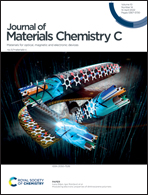Highly efficient solution-processed white organic light-emitting diodes based on a co-host system by controlling energy transfer among different emitters†
Abstract
High quality and efficient solution-processed phosphorescent white organic light-emitting diodes (WOLEDs) were designed and fabricated by controlling the ratio of the two hosts and adjusting the doping concentrations of the three primary emitters. Three iridium complexes, bis(2-methyldibenzo[f,h]quinoxaline)(acetylacetonate)iridium(III) (Ir(MDQ)2(acac)), tris(2-(4-tolyl)-phenylpyridine)iridium (Ir(mppy)3) and iridium(III) bis[(4,6-difluorophenyl)pyridinato-N,C20′]picolinate (FIrpic), were chosen as emitters. Two different types of material, 4,4′,4′′-tri(9-carbazoyl)triphenylamine (TcTa) and 9-(4-tert-butylphenyl)-3,6-bis(triphenylsilyl)-9H-carbazole (CzSi), were utilized to establish the co-host system. The optimized solution-processed WOLEDs exhibited a maximum current efficiency of 30.25 cd A−1, an external quantum efficiency (EQE) of 14.3% and a brightness of 20 670 cd m−2. In particular, a color rendering index (CRI) as high as 80 was obtained by this WOLED. With increasing brightness from 1000 to 5000 cd m−2, the Commission Internationale de l’Eclairage (CIE) coordinates of the optimized WOLED shifted slightly from (0.43, 0.42) to (0.40, 0.42), indicating the excellent spectrum stability. This work demonstrated the efficacy of accurately controlling the host-to-guest energy transfer in obtaining high-performance solution-processed WOLEDs.



 Please wait while we load your content...
Please wait while we load your content...